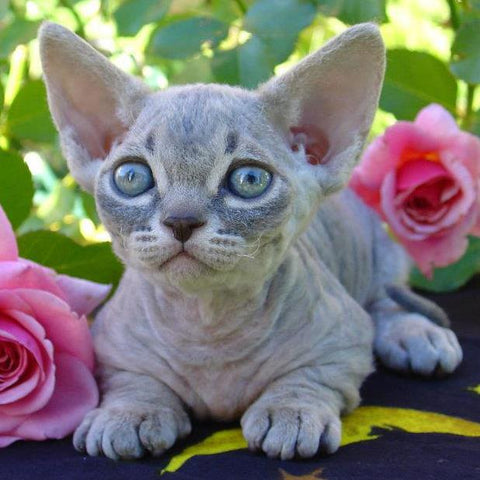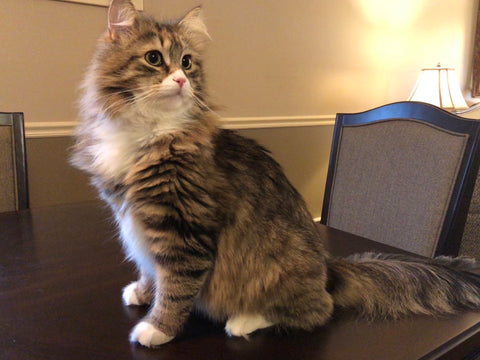When it comes to cats, you might picture a regal-looking kitty perched upon the back of your sofa, nibbling daintily out of a decorative bowl, or perhaps a frisky feline playfully swatting at the red dot of a laser pointer (cats are obsessed with those things)! Cats are known for having unique personalities and dispositions, but many cats take unique to the next level. These cats are the rare breeds like the Peterbald, Korat, and Chartreux that aren’t kitties you see often.
20 of the Rarest Cat Breeds in the World
What makes a cat rare? Is it the way it looks? Is it the fact that there are only a handful in existence, or maybe it’s just found in a particular part of the globe? Whatever the reason, rare cats are exceptional, and most of these breeds are recognized by the Cat Fanciers’ Association (CFA). If you decide to get a rare cat, make sure to find a reputable breeder, which is good advice no matter what type of cat or dog you want to bring home.
Here is a look at 20 of the rarest cat breeds from around the world:

1. American Bobtail: This playful and intelligent feline loves to be a family member and is extremely devoted to its human companions. American Bobtails were developed initially via natural selection; experienced breeders found domestic bobtails throughout the USA and produced this loving breed. This cat also does well with other animals, including dogs, and can even be leash trained!
2. American Wirehair: This short-haired, even-tempered kitty has a springy coat and resulted from a spontaneous mutation in a litter of farm cats in 1966. Its distinctive coat is what makes it stand out from other breeds. This cat is quiet and loving and makes an excellent pet.
3. Bombay: This glossy-coated black cat looks like a small panther, with its sleek coat and copper eyes. The Bombay is a hybrid, produced from breeding a sable-coated Burmese with a black American Shorthair. This cat loves to fetch and is an affectionate, intelligent companion.
4. British Shorthair: This stocky, short-haired feline has a calm and quiet disposition and loves to be around people. This kitty is considered one of the oldest English breeds, and its lineage can be traced back to Rome’s domesticated cats.
5. Burmilla: This silvery-hued cat features a beautiful and distinct face and comes in long-haired and short-haired varieties. The first litter of Burmilla kitties was produced from a Chinchilla Persian and a Lilac Burmese back in 1981. This cat is amiable and playful, and it is very rare in the United States.
6. Chartreux: This muscular cat features a short-haired blue coat and is a historic breed of France. There is some speculation of its exact origin, but one theory is it was the companion to Carthusian monks in France, taking a vow of silence along with the monks, which is why this breed is so quiet today. Whatever its backstory, the Chartreux makes a loyal and devoted family pet.

7. Cornish Rex: This short-haired feline is very active and playful, but also extremely affectionate. It comes in many colors and patterns, and its stand-out features are its curly-textured coat, high cheekbones, and large ears perched high upon its head.
8. Egyptian Mau: This athletic feline features a short-haired, spotted coat that gives it an exotic appearance. Egyptian pharaohs once worshipped these cats, and today, these kitties enjoy the company of their families but expect a lot of attention and like things done their way. The Egyptian Mau possesses swift reflexes and a definite sense of elegance and grace.
9. European Burmese: This affectionate kitty is very intelligent and loves to be around people. It loves to play but also is happy to curl up in your lap and snuggle. The first litter of European Burmese came from the mix of a Burmese named Wong Mau (the first Burmese cat introduced to the Western world) with a Siamese cat in the 1930s in the United States.
10. Havana Brown: Featuring a short-haired, chocolate-brown coat, this inquisitive feline features entrancing green eyes and gets along well with people and pets. It originated from England when black cats were mated with Siamese to try and produce a brown cat. The breed came to the USA in the 1950s.

11. Korat: Energetic and playful, but gentle, this cat was first discovered in Thailand, in the Korat province. It features a heart-shaped face and shimmery, blue coat, and is considered one of the “good luck cats” in Thailand.

12. LaPerm: This curly-coated cat can be short or long-haired, and it is very affectionate but also loves to be active. The basis for this breed was a kitten in a litter of barn cats in Oregon in 1982. The kitten was born with a mutation in which it had no hair, then started to grow curly, soft hair about 8 weeks later. Eventually, cats with these mutations were bred together to create the LaPerm, which means “wavy,” or “rippled.”

13. Minskin: This mix between a Munchkin and a Sphynx has a very distinct look, with a body that sits low to the ground, large ears, and big, round eyes. It got its start in Boston in 1988, and there are very few in existence. The Minskin is playful and smart and resembles the Corgi of the canine world.
14. Norwegian Forest Cat: This sweet, but active kitty features a long-haired, dense coat and stocky build. Hailing from Norway, this cat has a triangle-shaped head with large, almond-shaped eyes. It is relatively rare in the United States and might have been aboard Viking ships in the days of old in Norway.
15. Peterbald: This breed originates from Russia, first created in St. Petersburg in 1994. It features a wiry body, large ears, and a short coat (or no hair at all) and is very loving, often seeming very dog-like. The Peterbald makes an excellent family pet and adores to be around its humans.
16. Siberian: This breed is native to Russia, and it is very rare to find this cat outside of its home country. Initially used for rodent control, this cat makes a loyal companion. Unlike many other felines, it likes to play in the water and could get used to taking a bath.
17. Singapura: This short-haired cat hails from Singapore and is affectionate, but it can also be demanding. It first showed up in the United States in the 1970s, and its intelligent and playful disposition makes it an excellent choice for a pet.
18. Sphynx: This extremely rare cat’s most striking feature is the fact that it has no hair. It is the product of a natural genetic mutation, first discovered in Toronto, Canada, in 1966. The Sphynx has loose skin, which creates its classic wrinkled look, and it is very playful and affectionate.
19. Turkish Angora: Originating in Turkey, this long-haired, curious feline has a distinctive appearance and playful nature. This breed is considered a national treasure in its home country, and it makes a beautiful family pet.
20. Turkish Van: This distinctive-looking kitty is all-white with a dash of color on its head and tail. It was first developed in the central and southwest areas of Asia and is very rare. The breed came to the United States in 1982, but it is hard to find outside its home country. This kitty has a sweet nature and likes to play in the water.
Think you would want to own one of these rare breeds? Whether you choose to add one of the more common cat breeds to your family or one of these more unique animals, you’re sure to find a feline friend that has a distinctive personality. To find out more exciting tidbits about cats and dogs, including everything from activities to litter boxes to training, check out the rest of our blog! We’re always adding useful resources and tips to help you learn more about your pets so you can be a fantastic pet parent!
















